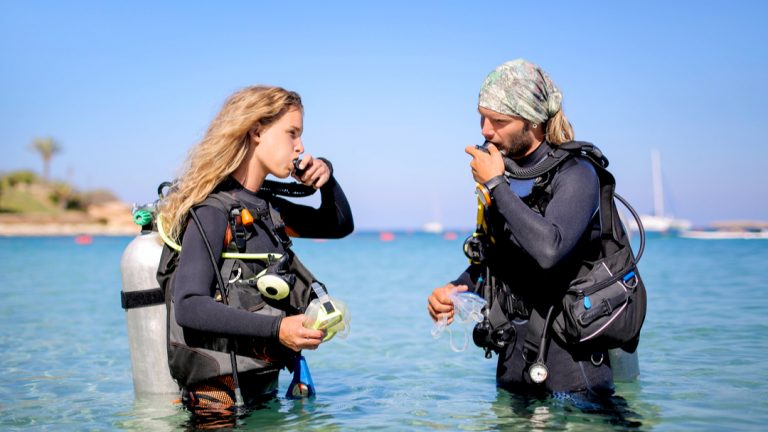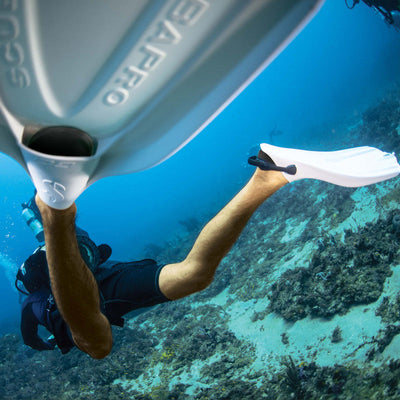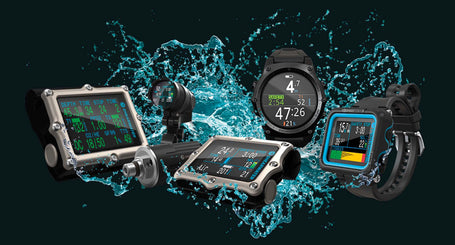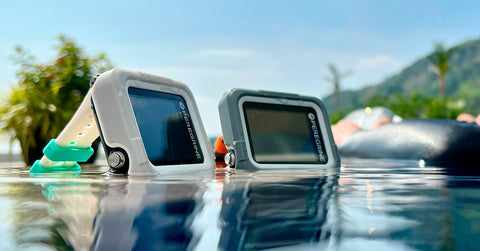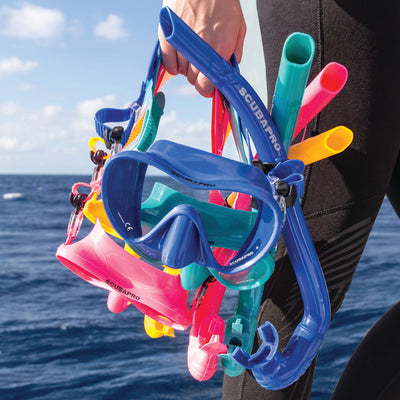Summary of Key Points:
- Scuba diving offers incredible rewards, but it also comes with many potential hazards. The more you know about scuba safety, the easier it will be to avoid emergencies and enjoy your time beneath the water’s surface.
- Staying above your maximum recommended depth is an important part of scuba safety. The maximum recommended depth is 60 ft for newer recreational divers and 130 ft for trained recreational divers—but you should never dive to any depths you feel uncomfortable at or unprepared for.
- Having the right safety gear is also critical for safe scuba diving. Essential gear includes a hood and gloves, a wetsuit or drysuit, a mask and snorkel, tanks and a regulator, fins, and weights. Advanced divers may use additional equipment such as dive watches and lines.
- Planning and training is also required to scuba dive safely. Make sure to take dive classes approved by an agency like the Professional Association of Diving Instructors (PADI) before you start. Santa Barbara Aquatics provides these classes.
Scuba diving is an incredible way to see marine life, explore underwater environments, and enjoy the sensation of moving weightlessly underwater. But safety should always be priority number one for divers, which means you need to understand both the risks and best practices for this popular aquatic pastime before you begin.
We’re here to help. Santa Barbara Aquatics is run by professional divers with countless years of combined experience. In the article below, we’ll teach you all about the diving safety equipment you’ll need and the protocol you’ll have to follow if you want to dive safely and responsibly.
Why Safety Matters for Scuba Divers
Taking the proper safety precautions can make the difference between life and death for scuba divers. Following proper protocols and guidelines helps ensure that you’re able to safely explore the underwater world.
Potential Hazards for Scuba Divers
Scuba diving comes with a lot of risks, but that doesn’t mean you should be scared to try it. Still, it’s vital to know what the potential dangers of scuba diving are so you can take steps to avoid them. The following list, while not exhaustive, covers many of the hazards divers can face:
- Decompression sickness (DCS), a condition caused by dissolved gasses coming out of solution in the body while ascending quickly from a dive.
- Barotrauma, a physical injury caused by changes in pressure, such as during a rapid ascent or descent.
- Ear and sinus squeeze, a condition caused by pressure changes during descent or ascent that can cause pain or injury to the ears or sinuses.
- Hypoxia, a condition that occurs when the body’s tissues do not receive enough oxygen.
- Hyperventilation (breathing too rapidly), which can lead to a decrease in carbon dioxide levels in the body and can cause unconsciousness.
- Shallow water blackout, a condition that can occur when a diver holds their breath for too long and loses consciousness.
- Carbon monoxide poisoning, a condition caused by inhaling carbon monoxide gas, which can occur if a diver's air supply becomes contaminated.
- Nitrogen narcosis, a condition caused by the effects of inhaling too much nitrogen at depth, which can cause hallucinations and disorientation.
- Equipment failure caused by dive gear such as masks, cylinders, or dive computers malfunctioning.
- Marine life injuries, which may occur when divers accidentally touch or harm marine animals.
- Drowning, which occurs when a diver is unable to surface for air.
- Cold water immersion, which can cause hypothermia and impact on the body functions.
- Severe sunburn, which can happen when divers spend a lot of time on or near the surface of the water.
- Motion sickness can happen when divers feel ill from the motion of the water.
- Altitude sickness can happen to divers who dive at high elevations (such as in mountain lakes).

Via Adobe Stock.
Maximum Depth for Scuba Divers
The maximum depth for recreational scuba diving is generally considered to be 130 ft (40 m). However, the maximum depth recommended for individual divers varies depending on the diver's experience, training, and the type of diving they are doing.
Technical divers, who receive special training, may go deeper than the recreational limit. However, it is highly recommended to get professional advice, training, and guidance before going deeper.
Going beyond the recommended recreational limit can increase your risk of decompression sickness and nitrogen narcosis, while limiting your visibility and putting more pressure on your equipment— all of which can increase the likelihood of an incident.
Recommended Safe Maximum Depths for Different Levels of Divers
One of the best ways to stay safe underwater is by knowing your limits and going no further than the depths you’re comfortable with. Here’s what we suggest for divers at different experience levels:
Beginner Divers:
If you’re new to recreational diving, go no deeper than 60 ft (18 m). Not only will you need more training to handle the challenges of deeper dives, but you’ll also probably need more advanced gear than starter equipment.
See Also:
Trained Recreational Divers:
Once you’ve completed advanced scuba training and have considerable experience under your belt, you can start going down to the maximum recreational limit of 130 ft (40m). Advanced technical divers sometimes go below these depths, but this requires specialized training and equipment. Also, remember that the same risks exist no matter how much training you have had, and never try to dive below depths that make you afraid or uncomfortable.
See Also:

Via Adobe Stock.
Scuba Diving Equipment
Scuba gear plays a massive role in your safety, so you’ll need to invest carefully in your equipment. Below, we’ll break down what you need if you’re just starting out, and what you’ll want to add to your kit as you progress.
Essential Gear for Scuba Diving
Every scuba diver needs the following equipment:
- Wetsuit or drysuit: exposure protection that helps regulate your body temperature when you’re underwater.
- Hood and gloves: to keep your face and hands warm.
- Mask and snorkel: to help you breathe when swimming near the surface. You’ll use a regulator hooked up to your tank to provide breathing gas when you’re underwater.
- Scuba tanks and regulators: your tanks hold your air (or diving gas if you’re diving at depths that require nitrox). Your regulator lets you breathe it safely by adjusting its pressure to match that of the surrounding environment.
- Fins: footwear that helps you propel yourself efficiently underwater.
- Weights: you’ll attach these to your suit to compensate for the buoyancy added by your tanks and suit.
Additional Equipment for More Advanced Divers
Once you’ve mastered the basics of scuba diving, you might want to incorporate the following into your gear.
- Buoyancy compensator: an adjustable vest or jacket that lets you create neutral buoyancy underwater so you can maintain your depth, and positive buoyancy at the surface so that you can float.
- Dive computer: devices that provide key insights in real-time about your current dive—such as depth, dive time, and more. Some also contain a digital compass to help you navigate underwater.
- Dive lines or reels: These can be used to mark points along your path so you can find your way back to the dive site. They’re often used for cave diving.
- Dive alert systems: Emergency devices you can use to signal the surface for rescue if something goes wrong during your dive.
- Stage tanks: Tanks that provide different decompression gasses at various depths during your ascent.
Importance of Proper Maintenance and Upkeep of Equipment
Proper maintenance of scuba equipment is vital to maintain its safety and performance. Get your scuba equipment inspected and serviced regularly by a certified technician, and make sure to clean and rinse it after each use. This includes checking for leaks, wear and tear, and proper functioning of all parts.
Always follow the manufacturer's guidelines for maintenance, and keep detailed records of all inspections and services. This keeps your gear in good working order and ready for your next dive.
Best Practices
Now that you have an idea of scuba’s risks and required equipment, here are some tips to help you stay as safe as possible on your underwater adventures:

Via Adobe Stock.
Use the Buddy System
We strongly recommend diving with a partner for mutual support in case of an emergency. It’s best to stay visible to each other, and maintain verbal communication through a radio or similar device whenever possible.
When using the buddy system, each diver monitors their partners air supply, dive computer, and overall well-being. This allows you to provide help for your partner quickly in case of an emergency. The buddy system also makes it easier to navigate while diving.
Plan Your Dive
The more you know about your environment before you dive, the easier it will be to anticipate and avoid hazards. You’ll also be able to explore more efficiently by reducing the risk of getting lost.
To plan a dive effectively, consider the following:
- Your dive site: where will you be diving?
- Dive conditions: what will the weather be like? What about the water temperature, tides, and visibility?
- Dive limits: what will your maximum depth be? What about your maximum dive time? Do not exceed your training or go out of your comfort zone.
Make sure to go over this information again immediately prior to your dive, in a dive briefing held with your partner or group. You should also take this opportunity to go over communication protocols (including any hand signals you might use while diving).

Via Adobe Stock.
Have a Strategy for Emergencies
You and your partner should have a plan in place for how to handle any emergency situations that arise during your dive. This will help prevent you from panicking and give you a procedure to rely on if something goes wrong.
Your emergency plan should include:
- Emergency signals: the signs you’ll use to let your partner or group know something is wrong.
- Rescue procedures: what you’ll do to rescue a diver in trouble or surface during an emergency (you’ll learn this in your training, but you should always make sure your dive group is on the same page)
- Checking your emergency equipment to make sure it’s working properly.
- Finding emergency support: make sure everyone knows where the nearest rescue teams are stationed and that they know where you’ll be before you dive.
- Communication devices: make sure someone is able to contact emergency services if you need them.
- Separation procedures: make sure everyone in your group knows what to do if you lose track of each other.
Get Proper Training Before You Dive
The tips in this article are a great summary of what to consider when you’re planning a scuba diving adventure, but they’re not a replacement for formal instruction and training. Remember, you need to get certified by a recognized training organization before you can legally dive in most countries.
Santa Barbara Aquatics offers dive classes for people at all experience levels. Our courses are approved by PADI (the Professional Association of Diving Instructors), one of the largest and most widely-recognized training agencies in the world.
Immerse Yourself in Scuba Diving Safety
Now that you have an overview of why scuba safety matters, the necessary equipment and training, and some tips you can use to stay safe underwater, it’s time to start planning your next dive! To learn more about scuba training or get help finding the best gear for your needs, contact Santa Barbara Aquatics. One of our team members will be happy to help make sure you’re prepared for the adventure of a lifetime.
